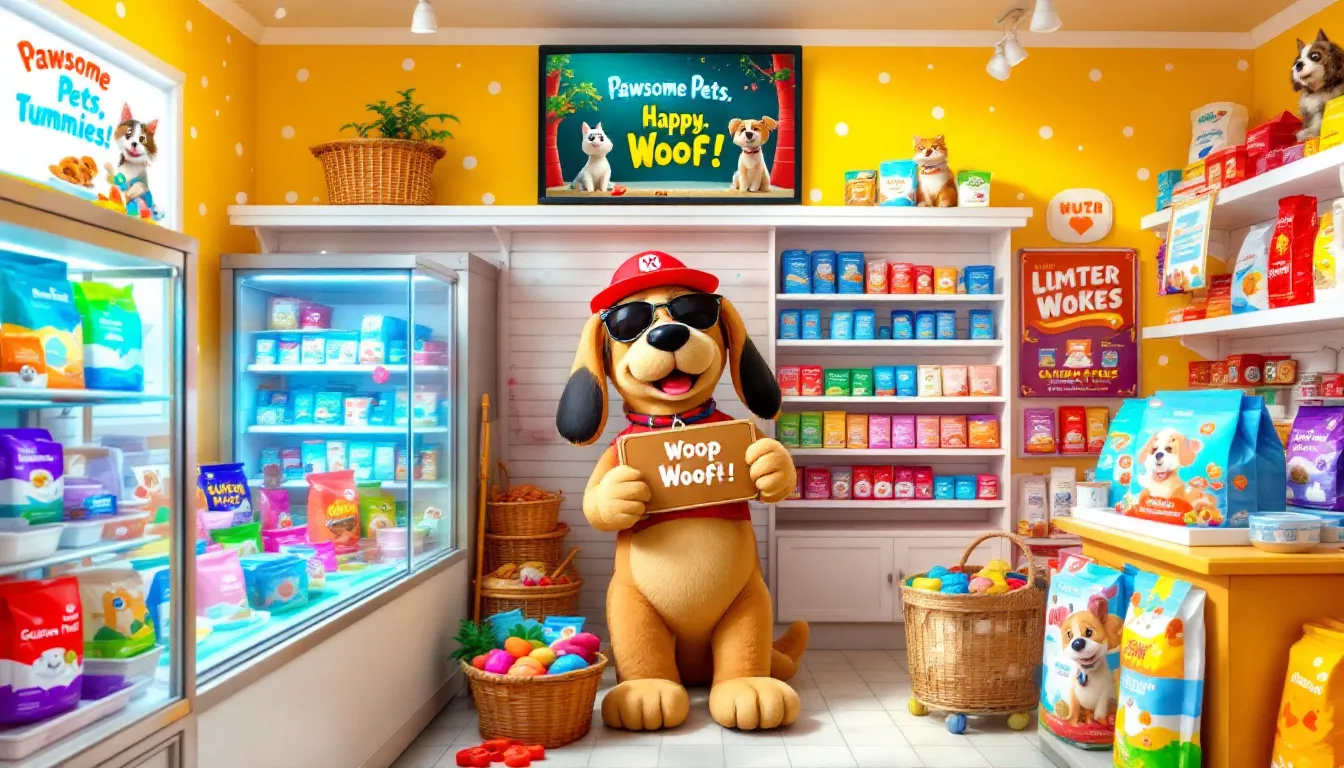Building a successful pet food brand involves more than just creating a product — it’s about standing out in a crowded market, including specific segments like dog food. Effective pet food branding sets your products apart, builds trust and drives loyalty among consumers. This blog post will explore essential strategies to help you create a strong, memorable brand that resonates with pet owners.
The importance of pet food branding

Branding is more than just a logo or a catchy tagline; it’s an integral part of your pet food business that significantly influences consumer decisions and loyalty. A well-crafted brand identity communicates the values and quality of your pet food products, resonating deeply with pet owners who are keen on ensuring the best for their pets.
Emotionally connecting with pet owners fosters trust and loyalty, which drives sales and long-term success in the pet food market for pet food companies.
Effective branding enhances customer loyalty and improves sales performance, making it critical for any pet food business strategy. It also promotes products that support a pet's health, aligning with the growing trend of pet owners prioritizing their pet's wellbeing.
Understanding the pet food market
The pet food market is a rapidly growing industry, driven by the increasing humanization of pets and the demand for premium, organic and healthy pet food options. According to market research, the global pet food market is expected to reach $129.9 billion by 2030, with the demand for premium and organic pet food skyrocketing. Pet owners are willing to spend more on high-quality pet food products that promote their pets’ health and well-being. The pet food market is crowded, with many brands competing for attention, making it essential for pet food businesses to create a strong brand identity and marketing strategy to stand out.
Crafting a unique brand identity
Establishing a unique selling proposition (USP) is the first step in crafting a distinctive brand identity. This core element determines how your brand is perceived and differentiated in the market. Modern pet owners seek authenticity and stories that resonate with their values and experiences.
For a pet treat business, creating a unique brand identity is crucial. A detailed business plan, proper registration and effective marketing strategies are essential to establish and promote your products successfully.
A relatable and emotional brand narrative can significantly enhance customer loyalty. Emotional stories that create a sense of community and trust are powerful branding tools. A strong brand voice that aligns with pet owners’ emotional connections fosters a deeper audience relationship.
A cohesive visual identity, including a memorable logo and color schemes, leaves a lasting impression in the pet market. Consistent visual elements across all marketing materials reinforce your brand identity and make it easily recognizable.
Creating a business plan
Creating a business plan is essential for starting a pet food business. A comprehensive business plan outlines the business idea, target customers, financial projections and marketing strategy. It helps identify the direction of the business and ensures that the business is well-structured and organized. A business plan should include market research, competitive analysis, product development, marketing and sales strategies, financial projections and operational plans. A well-crafted business plan can help pet food businesses secure funding, attract investors and make informed decisions.
Effective marketing strategies for pet food brands

Building brand recognition and driving pet food sales require effective marketing strategies. Social media marketing promotes pet food products and engages customers. Platforms like Instagram and Facebook provide opportunities to connect with pet owners and build a loyal following. Partnering with influencers in the pet care sector can expand your brand’s reach and attract a larger audience.
When selling pet food, it is crucial to comply with health and safety standards set by authorities like the Food Standards Agency. Ensuring compliance not only protects your customers but also enhances your brand integrity. Incorporating charitable initiatives into your business can further boost brand loyalty and awareness among socially conscious pet owners.
Local SEO helps pet food businesses attract customers searching for nearby products. A robust local SEO strategy boosts visibility and enhances local search rankings. Creating engaging content tailored to pet owners’ needs can significantly improve website traffic and customer retention.
Showcasing customer feedback on your website and social media builds trust with potential customers. Pay-per-click (PPC) advertising effectively targets customers early in their buying journey, especially when aligned with popular pet owner search queries. Email marketing campaigns also build customer loyalty by regularly communicating with pet owners and offering personalized promotions.
Market segmentation
Market segmentation is the process of dividing the pet food market into smaller groups based on demographics, behavior and preferences. The pet food market can be segmented into dry pet food, wet pet food and treats & snacks. Dry pet food is the most popular type of pet food, while wet pet food is gaining popularity due to its high moisture content. Treats & snacks are becoming increasingly popular as a way to reward pets and bond with them. Pet food businesses can use market segmentation to identify their target audience and create products that cater to their specific needs and preferences.
Leveraging high-quality ingredients
.jpg?width=514&height=288&name=Untitled%20design%20(27).jpg)
.jpg?width=436&height=291&name=Untitled%20design%20(28).jpg)
High-quality ingredients are the cornerstone of a successful pet food brand, supporting pets’ health and well-being by meeting their optimal nutritional needs. Diets with natural ingredients help prevent health issues and promote longer life spans.
Demand for premium pet food and organic pet foods is rising due to increasing consumer awareness of pet health. Pet owners are more interested in wellness products with functional ingredients that maintain their pets’ health in the global pet food market growth and the pet food industry.
High-quality pet food should include protein-rich components, whole grains, fruits and vegetables. Real meat as the first ingredient ensures high quality. For example, dry dog food often features these high-quality ingredients, providing balanced nutrition and convenience. Natural pet foods typically avoid artificial preservatives, opting for safer alternatives like vitamin E.
Packaging that stands out

Packaging significantly influences a pet owner’s choice of food product. Convenience and sustainability are increasingly important in pet food packaging, with easy-to-open packages, eco-friendly materials, bold colors and sleek designs. Captivating package design greatly impacts decision-making.
Eye-catching visuals and clear product information enhance a pet food brand’s appeal. Effective packaging design should include colorful illustrations or photos, a clear nutrition label and reflect the product’s quality. For instance, wet food can benefit from packaging that highlights its nutritious ingredients and easy-to-serve format, making it more appealing to health-conscious pet owners.
Utilizing social media and influencers
Social media and influencers enhance brand visibility and trust. Collaborating with influencers amplifies your brand’s reach and creates a trustworthy image for your pet food products. Social media campaigns can effectively target pet parents, a growing demographic of pet owners who regard their pets as family members and prioritize their health and well-being. Influencer marketing taps into the loyal followings of pet enthusiasts on social media.
Influencers’ emotional connection with their pets resonates deeply with audiences, increasing product acceptance. When selecting influencer partners, engagement metrics like comments and shares are more important than follower counts.
Influencer-conducted giveaways can significantly boost engagement and attract new potential customers.
Personalization in pet food products
Personalization in pet food is on the rise and becoming increasingly popular among consumers. Pet owners seek products tailored to their pets’ unique requirements, ensuring their furry friends receive the best care possible. Personalized nutrition involves customizing food based on individual needs and preferences to support a pet's health, providing the best possible diet for each pet.
Brands should develop distinctive recipes and use specific ingredients catering to individual needs. This approach meets the demand for personalization and sets your brand apart in the competitive pet food market.
Strategic pricing for competitive edge
Strategic pricing is crucial for maintaining a competitive edge in the pet food market. When selling pet food, it ensures your products are competitively priced while maintaining profitability. Factors like supply costs and expenses must be considered when setting prices.
Reevaluating your pricing strategy every 6 to 12 months helps adapt to market conditions and operational cost changes. Value-based pricing focuses on the perceived worth of products by customers rather than just production costs.
Tiered service packages allow businesses to cater to various customer needs and budgets.
Building customer loyalty programs
Customer loyalty programs encourage repeat purchases by rewarding loyal customers. These programs have evolved over centuries and are crucial for maintaining customer engagement. Different types of loyalty programs, such as tiered rewards or points-based systems, can be chosen based on the nature of the pet food offerings.
Implementing a loyalty program can significantly benefit a pet treat business by fostering customer retention and encouraging repeat purchases.
Selecting appropriate rewards, whether discounts or exclusive access, is critical for loyalty program effectiveness. Add-on services can enhance customer experiences and increase overall revenue.
Refreshing loyalty program offerings with new incentives and seasonal rewards helps maintain customer engagement.
Local SEO and online visibility
Local SEO is essential for pet food businesses to increase their online visibility and attract local customers. Pet food businesses can optimize their website for local search by including location-specific keywords, creating a Google My Business listing and building high-quality local citations. Local SEO can help pet food businesses appear on the first page of search engine results, increasing their visibility and driving more traffic to their website. Additionally, pet food businesses can use online directories and review sites to increase their online presence and build their reputation.
Email marketing campaigns
Email marketing campaigns are an effective way for pet food businesses to connect with their customers, promote their products and build their brand. Pet food businesses can create email marketing campaigns that offer exclusive discounts, promotions and educational content to their subscribers. Email marketing campaigns can help pet food businesses build a loyal customer base, increase sales and drive website traffic. Pet food businesses can use email marketing automation tools to personalize their emails, segment their list and track their results. By creating effective email marketing campaigns, pet food businesses can stay top of mind with their customers and drive business growth.
GC Consulting services for pet food businesses
GC Consulting supports pet food businesses by enhancing branding, conducting market research and developing tailored strategies. Collecting and analyzing customer feedback is critical for informing branding and product strategies.
Consulting services can significantly benefit a pet treat business by helping to establish a detailed business plan, register with the appropriate authorities and explore effective marketing strategies.
Strategy development services include designing successful loyalty programs tailored to target market preferences. GC Consulting’s branding assistance focuses on creating a memorable identity that resonates with pet owners, facilitating brand loyalty and recognition.
Summary
Building a strong pet food brand requires a comprehensive approach that includes crafting a unique brand identity, leveraging high-quality ingredients and implementing effective marketing strategies. For instance, strong branding can significantly benefit dog food products by emphasizing the quality of ingredients, such as premium and organic options, and highlighting the nutritional value. Personalization, strategic pricing and customer loyalty programs play vital roles in differentiating your brand and driving success.
As the pet food market continues to grow, staying ahead of trends and maintaining a strong brand presence is crucial. By following these strategies, you can create a brand that resonates with pet owners and stands out in the competitive dog food industry.
Frequently asked questions
Why is branding important in the pet food industry?
Branding is crucial in the pet food industry as it shapes consumer trust and loyalty, ultimately driving sales and fostering long-term success. Establishing a strong brand can differentiate products in a competitive market.
How can I create a unique brand identity for my pet food business?
To create a unique brand identity for your pet food business, establish a distinct value proposition, develop an emotional brand narrative, and ensure your visual identity is cohesive. This approach will help you stand out in a competitive market. GC Consulting helps you create that unique brand identity. Check out their consulting services.
What are the benefits of using high-quality ingredients in pet food?
Using high-quality ingredients in pet food significantly enhances your pet's health and well-being by providing optimal nutrition and helping to prevent health issues. Prioritizing these ingredients is essential for ensuring your pet's longevity and vitality.
How can social media and influencers help my pet food brand?
Utilizing social media and influencers can significantly boost your pet food brand's visibility and credibility, while also fostering emotional connections with pet owners. This strategy not only broadens your audience reach but also builds trust in your brand.



